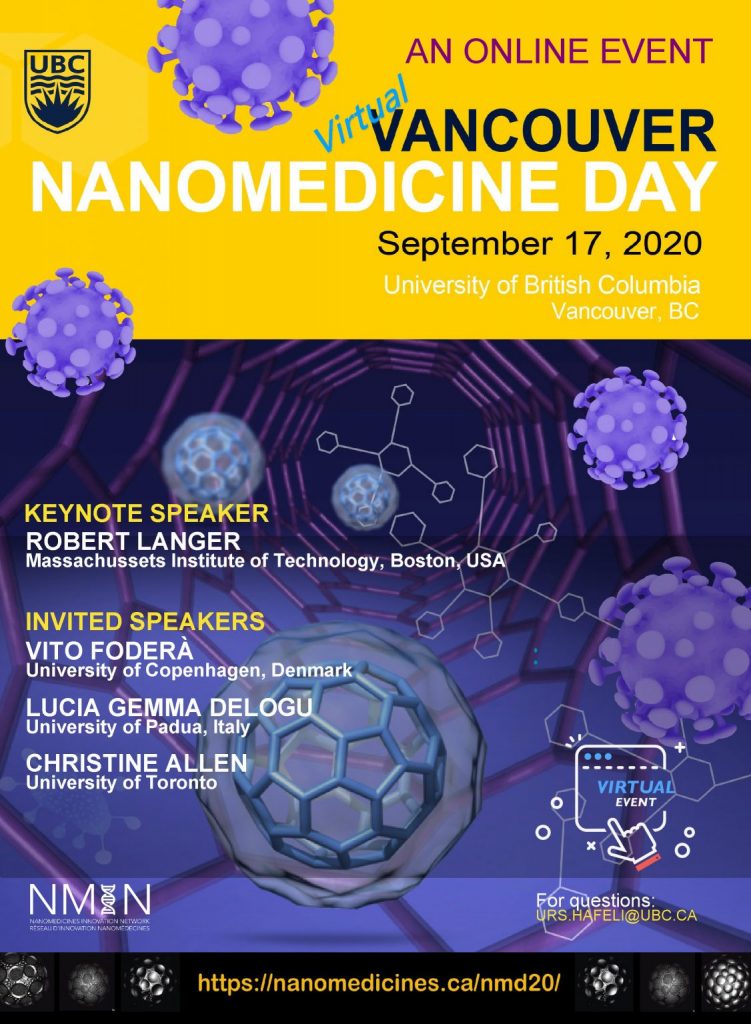Canada’s NanoMedicines Innovation Network (NMIN) must have been excited over the COVID-19 vaccine news (Pfizer Nov. 9, 2020 news release) since it’s a Canadian company (Acuitas Therapeutics) that is providing the means of delivering the vaccine once it enters the body.
Here’s the company’s president and CEO [chief executive officer], Dr. Thomas Madden explaining his company’s delivery system (from Acuitas’ news and events webpage),
For anyone who might find a textual description about the vaccine helpful, I have a Nov. 9, 2020 article by Adele Peters for Fast Company,
… a handful of small biotech companies began scrambling to develop vaccines using an as-yet-unproven technology platform that relies on something called messenger RNA [ribonucleic acid], usually shortened to mRNA …
Like other vaccines, mRNA vaccines work by training the immune system to recognize a threat like a virus and begin producing antibodies to protect itself. But while traditional vaccines often use inactivated doses of the organisms that cause disease, mRNA vaccines are designed to make the body produce those proteins itself. Messenger RNA—a molecule that contains instructions for cells to make DNA—is injected into cells. In the case of COVID-19, mRNA vaccines provide instructions for cells to start producing the “spike” protein of the new coronavirus, the protein that helps the virus get into cells. On its own, the spike protein isn’t harmful. But it triggers the immune system to begin a defensive response. As Bill Gates, who has supported companies like Moderna and BioNTech through the Gates Foundation, has described it, “you essentially turn your body into its own manufacturing unit.”
…
Amy Judd’s Nov. 9, 2020 article for Global news online explains (or you can just take another look at the video to refresh your memory) how the Acuitas technology fits into the vaccine picture,
Vancouver-based Acuitas Therapeutics, a biotechnology company, is playing a key role through a technology known as lipid nanoparticles, which deliver messenger RNA into cells.
“The technology we provide to our partners is lipid nanoparticles and BioNTech and Pfizer are developing a vaccine that’s using a messenger RNA that tells our cells how to make a protein that’s actually found in the COVID-19 virus,” Dr. Thomas Madden, president and CEO of Acuitas Therapeutics, told Global News Monday [Nov. 9, 2020].
“But the messenger RNA can’t work by itself, it needs a delivery technology to protect this after it’s administered and then to carry it into the cells where it can be expressed and give rise to an immune response.”
Madden said they like to think of the lipid nanoparticles as protective wrapping around a fragile glass ornament [emphasis mine] being shipped to your house online. That protective wrapping would then make sure the ornament made it to your house, through your front door, then unwrap itself and leave in your hallway, ready for you to come and grab it when you came home.
…
Acuitas Therapeutics employs 29 people and Madden said he believes everyone is feeling very proud of their work.
“Not many people are aware of the history of this technology and the fact that it originated in Vancouver,” he added.
“Dr. Pieter Cullis was one of the key scientists who brought together a team to develop this technology many, many years ago. UBC and Vancouver and companies associated with those scientists have been at the global centre of this technology for many years now.
“I think we’ve been looking for a light at the end of the tunnel for quite some time. I think everybody has been hoping that a vaccine would be able to provide the protection we need to move out of our current situation and I think this is now a confirmation that this hope wasn’t misplaced.”
…
Nanomedicine in Vancouver
For anyone who’s curious about the Canadian nanomedicine scene, you can find out more about it on Canada’s NanoMedicines Innovation Network (NMIN) website. They recently held a virtual event (Vancouver Nanomedicine Day) on Sept. 17, 2020 (see my Sept. 11, 2020 posting for details), which featured a presentation about Aquitas’ technology.
Happily, the organizers have posted videos for most of the sessions. Dr. Ying Tam of Acuitas made this presentation (about 22 mins. running time) “A Novel Vaccine Approach Using Messenger RNA‐Lipid Nanoparticles: Preclinical and Clinical Perspectives.” If you’re interested in that video or any of the others go to the NanoMedicines Innovation Network’s Nanomedicine Day 2020 webpage.
